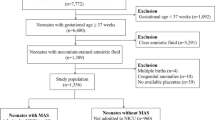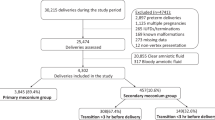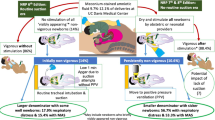Abstract
Meconium aspiration syndrome (MAS) is associated with increased risk for perinatal mortality and morbidities. To provide an overview of the advances in our knowledge concerning the obstetric approaches to the prevention of MAS. The evidence of the effectiveness of intrapartum surveillance, amnioinfusion, and delivery room management in the prevention of MAS are reviewed in the present paper. Meconium aspiration syndrome remains one of the most common but challenging conditions for obstetricians and pediatricians. The available evidence did not demonstrate a beneficial effect of either of obstetric strategies in the prevention of MAS.
This is a preview of subscription content, access via your institution
Access options
Subscribe to this journal
Receive 12 print issues and online access
$259.00 per year
only $21.58 per issue
Buy this article
- Purchase on Springer Link
- Instant access to full article PDF
Prices may be subject to local taxes which are calculated during checkout
Similar content being viewed by others
References
Cleary GM, Wiswell TE . Meconium-stained amniotic fluid and the meconium aspiration syndrome: an update. Pediatr Clin North Am 1998; 45: 511–529.
Wiswell TE, Tuggle JM, Turner BS . Meconium aspiration syndrome: have we made a difference? Pediatrics 1990; 85: 715–721.
Scott H, Walker M, Gruslin A . Significance of meconium-stained amniotic fluid in the preterm population. J Perinatol 2001; 21: 174–177.
Usher RH, Boyd ME, McLean FH, Kramer MS . Assessment of fetal risk in postdate pregnancies. Am J Obstet Gynecol 1988; 158: 259–264.
Ostrea EM, Naqvi M . The influence of gestational age on the ability of the fetus to pass meconium in utero. Acta Obstet Gynecol Scand 1982; 61: 275–277.
Eden RD, Seifert LS, Winegar A, Spellacy W . Perinatal characteristics of uncomplicated postdate pregnancies. Obstet Gynecol 1987; 69: 296–299.
Steer PJ, Eigbe F, Lissauer TJ, Beard RW . Interrelationships among abnormal cardiotocograms in labor, meconium staining of the amniotic fluid, arterial cord blood pH, and Apgar scores. Obstet Gynecol 1989; 74: 715–721.
Lucas A, Adrian TE, Christofides N, Bloom SR, Aynsley-Green A . Plasma motilin, gastrin and enteroglucagon and feeding in the human newborn. Arch Dis Child 1980; 55: 673–677.
Miller FC, Sacks DA, Yeh SY, Paul RH, Schifrin BS, Martin Jr CB et al. Significance of meconium during labor. Am J Obstet Gynecol 1975; 122: 573–580.
Bochner CJ, Medearis AL, Ross MG, Oakes GK, Jones P, Hobel CJ et al. The role of antepartum testing in the management of postterm pregnancies with heavy meconium in early labor. Obstet Gynecol 1987; 69: 903–907.
Ahanya SN, Lakshmanan J, Morgan BL, Ross MG . Meconium passage in utero: mechanisms, consequences, and management. Obstet Gynecol Surv 2005; 60: 45–56.
Brown BL, Gleicher N . Intrauterine meconium aspiration. Obstet Gynecol 1981; 57: 26–29.
Davis RO, Phillips III JB, Harris Jr BA, Wilson ER, Huddleston JF . Fatal meconium aspiration syndrome occurring despite airway management considered appropriate. Am J Obstet Gynecol 1985; 151: 731–736.
Urbaniak KJ, McCowan LM, Townend KM . Risk factors for meconium aspiration syndrome. Aust N Z J Obstet Gynaecol 1996; 36: 401–406.
Hernandez C, Little BB, Dax JS, Gilstrap III LC, Rosenfeld CR . Prediction of the severity of meconium aspiration syndrome. Am J Obstet Gynecol 1993; 169: 61–70.
Falciglia HS . Failure to prevent meconium aspiration syndrome. Obstet Gynecol 1988; 71: 349–353.
Coltart TM, Byrne DL, Bates SA . Meconium aspiration syndrome: a 6-year retrospective study. Br J Obstet Gynaecol 1989; 96: 411–414.
Bhutani VK, Chima R, Sivieri EM . Innovative neonatal ventilation and meconium aspiration syndrome. Indian J Pediatr 2003; 70: 421–427.
Wiswell TE . Advances in the treatment of the meconium aspiration syndrome. Acta Paediatr Suppl 2001; 90: 28–30.
Rossi EM, Philipson EH, Williams TG, Kalhan SC . Meconium aspiration syndrome: intrapartum and neonatal attributes. Am J Obstet Gynecol 1989; 161: 1106–1110.
Katz VL, Bowes WA . Meconium aspiration syndrome: reflections on a murky subject. Am J Obstet Gynecol 1992; 166: 171–183.
Ghidini A, Spong CY . Severe meconium aspiration syndrome is not caused by aspiration of meconium. Am J Obsted Gynecol 2001; 185: 931–938.
Jovanovic R, Nguyen HT . Experimental meconium aspiration in guinea pigs. Obstet Gynecol 1989; 73: 652–656.
Greenough A . Meconium aspiration syndrome—prevention and treatment. Early Hum Dev 1995; 41: 183–192.
Meis PJ, Hall III M, Marshall JR, Hobel CJ . Meconium passage: a new classification for risk assessment during labor. Am J Obstet Gynecol 1987; 131: 509–513.
Falciglia HS, Henderschott C, Potter P, Helmchen R . Does DeLee suction at the perineum prevent meconium aspiration syndrome? Am J Obstet Gynecol 1992; 167: 1243–1249.
Alexander GR, Hulsey TC, Robillard PY, De Caunes F, Papiernik E . Determinants of meconium stained amniotic fluid in term pregnancies. J Perinatol 1994; 14: 259–263.
Meydanli MM, Dilbaz B, Caliskan E, Dilbaz S, Haberal A . Risk factors for meconium aspiration syndrome in infants born through thick meconium. Int J Gynaecol Obstet 2001; 72: 9–15.
Paz Y, Solt I, Zimmer EZ . Variables associated with meconium aspiration syndrome in labours with thick meconium. Eur J Obstet Gynecol Reprod Biol 2001; 94: 27–30.
Dargaville PA, Copnell B, Australian and New Zealand Neonatal Network. The epidemiology of meconium aspiration syndrome: incidence, risk factors, therapies, and outcome. Pediatrics 2006; 117: 1712–1721.
Sriram S, Wall SN, Khoshnood B, Singh JK, Hsieh HL, Lee KS . Racial disparity in meconium stained amniotic fluid and meconium aspiration syndrome in the United States, 1989 to 2000. Obstet Gynecol 2003; 102: 1262–1268.
Sedaghatian MR, Othman L, Hossain MM, Vidyasagar D . Risk of meconium stained amniotic fluid in different ethnic groups. J Perinatol 2000; 20: 257–261.
Shy KK, Larson EB, Luthy DA . Evaluating a new technology: the effectiveness of electronic fetal heart rate monitoring. Annu Rev Public Health 1987; 8: 165–190.
Lumley J . Does continuous intrapartum fetal monitoring predict long-term neurological disorders? Paediatr Perinat Epidemiol 1988; 2: 299–307.
Paneth N, Bommarito M, Stricker J . Electronic fetal monitoring and later outcome. Clin Invest Med 1993; 16: 159–165.
Neilson JP . Electronic fetal heart rate monitoring during labor: information from randomized trials. Birth 1994; 21: 101–104.
Graham EM, Petersen SM, Christo DK, Fox HE . Intrapartum electronic fetal heart rate monitoring and the prevention of perinatal brain injury. Obstet Gynecol 2006; 108: 656–666.
Thacker SB, Stroup DF, Peterson HB . Efficacy and safety of intrapartum electronic fetal monitoring: an update. Obstet Gynecol 1995; 86: 613–620.
Alfirevic Z, Devane D, Gyte GM . Continuous cardiotocography (CTG) as a form of electronic fetal monitoring (EFM) for fetal assessment during labour. Cochrane Database Syst Rev 2006; 3: CD006066.
Starks GC . Correlation of meconium-stained amniotic fluid, early intrapartum pH, and Apgar scores as predictors of perinatal outcome. Obstet Gynecol 1980; 56: 604–609.
Hageman JR . Meconium staining of the amniotic fluid: the need for reassessment of management by obstetricians and pediatricians. Curr Probl Pediatr 1993; 23: 396–401.
Krebs HB, Petres RE, Dunn LT, Jordaan HVF, Segreti A . Intrapartum Fetal Heart Rate Monitoring. III. Association of meconium with abnormal fetal heart rate patterns. Am J Obstet Gynecol 1980; 137: 936–943.
Umstad MP . The predictive value of abnormal fetal heart rate patterns in early labour. Aust NZJ Obstet Gynaecol 1993; 33: 145–149.
Miyazaki FS, Nevarez F . Saline amnioinfusion for relief of repetitive variable decelerations. A prospective randomized study. Am J Obstet Gynecol 1985; 153: 301–306.
Wang CC, Rogers MS . Lipid peroxidation in cord blood: a randomised sequential airs study of prophylactic saline amnioinfusion for intrapartum oligohydramnios. Br J Obstet Gynaecol 1997; 104: 1145–1151.
Nageotte MP, Freeman RK, Garite TJ, Dorchester W . Prophylactic intrapartum amnioinfusion in patients with premature rupture of membranes. Am J Obstet Gynecol 1985; 153: 557–562.
Nageotte MP, Bertucci L, Towers CV, Lagrew DL, Modaniou H . Prophylactic amnioinfusion in pregnancies complicated by oligohydramnios: a prospective study. Obstet Gynecol 1991; 77: 677–680.
Owen J, Henson BV, Hauth JC . A prospective randomized study of saline solution amnioinfusion. Am J Obstet Gynecol 1990; 162: 1146–1149.
MacGregor SM, Banzhaf WC, Silver RK, Depp R . A prospective randomized evaluation of intrapartum amnioinfusion. Fetal acid–base status and cesarean delivery. J Reprod Med 1991; 36: 69–73.
Schrimmer DB, Macri CJ, Paul RH . Prophylactic amnioinfusion as a treatment for oligohydramnios in laboring patients: a prospective, randomized trial. Am J Obstet Gynecol 1991; 165: 972–975.
Chauhan SP, Rutherford SE, Hess LW, Morrison JC . Prophylactic intrapartum amnioinfusion for patients with oligohydramnios. J Reprod Med 1992; 37: 817–820.
Pitt C, Sanchez-Ramos L, Kaunitz AM, Gaudier F . Prophylactic amnioinfusion for intrapartum oligohydramnios: a meta-analysis of randomized controlled trials. Obstet Gynecol 2000; 96: 861–866.
Hofmeyr GJ . Amnioinfusion for meconium-stained liquor in labor. Cochrane Database Syst Rev 2002; 1: CD000014.
Xu H, Hofmeyr J, Roy C, Fraser W . Intrapartum amnioinfusion for meconium stained amniotic fluid: a systematic review of randomised controlled trials. BJOG 2007; 114: 383–390.
Fraser WD, Hofmeyr GJ, Lede R, Faron G, Alexander S, Goffinet F et al. Amnioinfusion for the prevention of the meconium aspiration syndrome. N Engl J Med 2005; 353: 909–917.
Wenstrom K, Andrews WW, Maher JE . Amnioinfusion survey: prevalence, protocols, and complications. Obstet Gynecol 1995; 86: 572–576.
Dragich DA, Ross AF, Chestnut DH, Wenstrom K . Respiratory failure associated with amnioinfusion during labor. Anesth Analg 1991; 72: 549–551.
Maher JE, Wenstrom KD, Hauth JC, Meis PJ . Amniotic fluid embolism after saline amnioinfusion: two cases and review of the literature. Obstet Gynecol 1994; 83: 851–854.
Dorairajan G, Soundararaghavan S . Maternal death after intrapartum saline amnioinfusion-report of two cases. Br J Obstet Gynaecol 2005; 112: 1331–1333.
ACOG Committee Obstetric Practice. ACOG Committee Opinion Number 346, October 2006: amnioninfusion does not prevent meconium aspiration syndrome. Obstet Gynecol 2006; 108: 1053.
Carson BS, Losey RW, Bowes Jr WA, Simmons MA . Combined obstetric and pediatric approach to prevent meconium aspiration syndrome. Am J Obstet Gynecol 1976; 126: 712–715.
Yoder BA, Kirsch EA, Barth WH, Gordon MC . Changing obstetric practices associated with decreasing incidence of meconium aspiration syndrome. Obstet Gynecol 2002; 99: 731–739.
Chishty AL, Alvi Y, Iftikhar M, Bhutta TI . Meconium aspiration in neonates: combined obstetric and paediatric intervention improves outcome. J Pak Med Assoc 1996; 46: 104–108.
Vain NE, Szyld EG, Prudent LM, Wiswell TE, Aguilar AM, Vivas NI . Oropharyngeal and nasopharyngeal suctioning of meconium-stained neonates before delivery of their shoulders: multicentre, randomised controlled trial. Lancet 2004; 364: 597–602.
Gregory GA, Gooding CA, Phibbs RH, Tooley WH . Meconium aspiration in infants—a prospective study. J Pediatr 1974; 85: 848–852.
Ting P, Brady JP . Tracheal suction in meconium aspiration. Am J Obstet Gynecol 1975; 122: 767–771.
Wiswell T, Henley MA . Intratracheal suctioning, systematic infection, and the meconium aspiration syndrome. Pediatrics 1992; 89: 203–206.
Linder N, Aranda JV, Tsur M, Matoth I, Yatsiv I, Mandelberg H et al. Need for endotracheal intubation and suction in meconium-stained neonates. J Pediatr 1988; 112: 613–615.
Wiswell TE, Gannon CM, Jacob J, Goldsmith L, Szyld E, Weiss K et al. Delivery room management of the apparently vigorous meconium-stained neonate: results of the multicenter, international collaborative trial. Pediatrics 2000; 105: 1–7.
Kresh MJ, Brion LP, Fleishman AR . Delivery room management of meconium stained neonates. J Perinatol 1991; 11: 46–48.
Bent RC, Wiswell TE, Chang A . Removing meconium from infant tracheae. Am J Dis Child 1992; 146: 1085–1089.
Peng TCC, Gutcher GR, Van Dorsten JP . A selective aggressive approach to the neonate exposed to meconium-stained amniotic fluid. Am J Obstet Gynecol 1996; 175: 296–303.
Yoder BA . Meconium-stained amniotic fluid and respiratory complications: impact of selective tracheal suction. Obstet Gynecol 1994; 83: 77–84.
Liu WF, Harrington T . The need for delivery room intubation of thin meconium in the low-risk newborn: a clinical trial. Am J Perinatol 1998; 15: 675–682.
Halliday HL, Sweet D . Endotracheal intubation at birth for preventing morbidity and mortality in vigorous, meconium-stained infants born at term. Cochrane Database Syst Rev 2001; 1: CD000500.
Author information
Authors and Affiliations
Corresponding author
Rights and permissions
About this article
Cite this article
Xu, H., Wei, S. & Fraser, W. Obstetric approaches to the prevention of meconium aspiration syndrome. J Perinatol 28 (Suppl 3), S14–S18 (2008). https://doi.org/10.1038/jp.2008.145
Published:
Issue Date:
DOI: https://doi.org/10.1038/jp.2008.145



